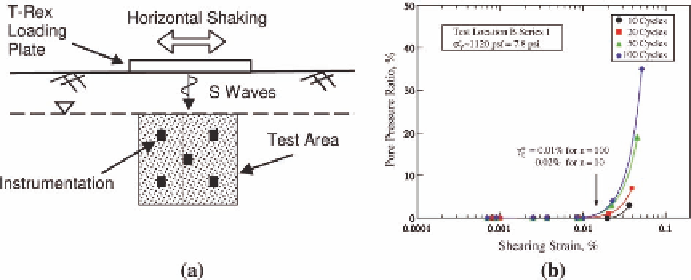Geoscience Reference
In-Depth Information
Fig. 7.6. In-situevaluation of liquefaction resistance: (a) testarea that isstage loaded
and (b) in-situpore pressure generation curves obtained fromone test (fromCox,, 2006)
Example 2 Nonlinear Shear Modulus Measurements Using a Surface Footing.
The sec-
ond example is presented in Figure7.5b. In this example, a 0.9-m diameter surface foot-
ingwasloadedwithaconstantverticalforce.Atthispoint,thefootingwasstagedloaded
with increasingly larger horizontal dynamic loads. Shear waves with increasing strains
amplitudeweremeasuredfromwhichtheG-log
relationshipswere
evaluated. The soil was a poorly graded sand and silty sand (SP-SM) that was lightly
cemented.ResultsfromanintermediatedynamicloadingstageareshowninFigure7.5b.
Measurements of G in the linear range (hence, G
max
) and in the nonlinear range were
clearlyconducted.Themaximumshearingstrainwasonly0.02%sincethiswasaninter-
mediate stage. The field G
γ
andG
/
G
max
-log
γ
/
G
max
-log
γ
relationship shows that the value of the elastic
(
γ
t
e
threshold strain
in the field is around 0.002% at the imposed stress level. Compari-
sonofthefieldrelationshipwithlaboratoryresultsusinganintactspecimenisalsoshown
in Figure7.5b.
)
Example 3 In-Situ Dynamic Liquefaction Test.
An in-situ dynamic liquefaction test is
underdevelopment(Rathjeetal.,2004;Cox,,2006).Itisdesignedtomeasureporewater
pressure generation under dynamic loading at field sites. T-Rex is used to provide the
dynamic loading. The generalized test configuration is illustrated in Figure7.6a. Shear
waves dynamically load the test area. The level of shaking is controlled by specifying
the number of cycles and their amplitudes. The shear waves induce cyclic shear strains
which generate excess pore water pressure in the test area. One example of testing at the
Wildlife Site in Imperial Valley, CA is shown in Figure7.6b. This work is discussed in
detail byCox, (2006).
4. Conclusions
Field seismic testing to determine V
s
and V
p
profiles at depths less than 75m is widely
done in geotechnical earthquake engineering. This profiling is defined as shallow
profiling herein, and many field methods are available. Deeper profiling is less often

